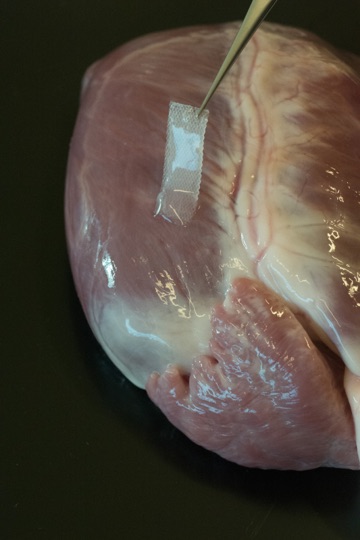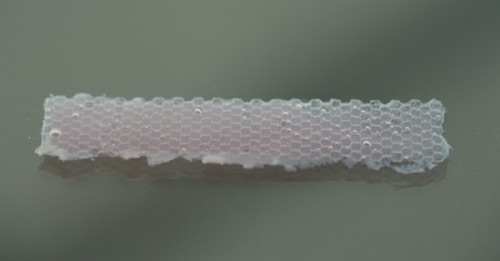3D Printed Cardiac Patch Mends Damaged Hearts

The cardiac patch supports high tensile strains, which is critical because it’s placed on a contracting heart. Image Courtesy of Miguel Castilho, Alain van Mil, Malachy Maher, Corina H.G. Metz, Gernot Hochleitner, Jürgen Groll, Pieter A. Doevendans, Keita Ito, Joost P.G. Sluijter, and Jos Malda; Melt Electrowriting Allows Tailored Microstructural and Mechanical Design of Scaffolds to Advance Functional Human Myocardial Tissue Formation; Advanced Functional Materials 2018; Copyright Wiley—VCH Verlag GmbH & Co. KGaA. Reproduced with permission.
Latest News
August 31, 2018
3D printing has rapidly become a big deal in medical applications. The technology is ushering in a new generation of custom prosthetics and surgical guides, is used to create life-like models of human organs like the heart and brain to serve as teaching props, and even serves as an experimental platform for producing on-demand pharmaceuticals. More recently, a form of 3D printing has been employed to create a cardiac patch used to mend compromised tissue cells after a heart attack.
Two Dutch laboratories—The Department of Orthopedics at the University Medical Center Utrecht in the Netherlands, and the Experimental Cardiology Laboratory at the same institute—came together for the research, combining their respective expertise in converging 3D printing technologies for regenerative medicine applications and specific cardiology knowledge. The multidisciplinary team of surgeons, engineers, biologists and materials scientists was trying to come up with a solution for patients with heart disease, particularly those that have suffered heart attacks.
The backdrop for the study: According to the researchers, heart disease costs the European Union over $6 billion annually (factoring in healthcare costs, productivity losses, and cost of care). Those suffering from a heart attack lose nearly half the cells in their heart, which makes the organ weaker. While the medical field has begun injecting new cells into the heart to grow muscle and prevent heart contractions, it’s not an effective approach as the cells often wash away. That led the team to experiment with biofabrication, a field converging 3D printing with regenerative medicine.
The team employed an electrohydrodynamic printing process known as melt electrowriting (MEW) to engineer 3D fiber scaffolds, which could help the newly injected cells remain in the live heart and grow. The stretchable microfiber scaffold, which featured a hexagonal or beehive design, was combined with specialized stem cells, with the aim of supporting the cells and improving their maturation, the study said.
 The team employed an electrohydrodynamic printing process known as melt electrowriting (MEW) to engineer stretchable 3D fiber scaffolds. Image Courtesy of Miguel Castilho, Alain van Mil, Malachy Maher, Corina H.G. Metz, Gernot Hochleitner, Jürgen Groll, Pieter A. Doevendans, Keita Ito, Joost P.G. Sluijter, and Jos Malda; Melt Electrowriting Allows Tailored Microstructural and Mechanical Design of Scaffolds to Advance Functional Human Myocardial Tissue Formation; Advanced Functional Materials 2018; Copyright Wiley—VCH Verlag GmbH & Co. KGaA. Reproduced with permission.
The team employed an electrohydrodynamic printing process known as melt electrowriting (MEW) to engineer stretchable 3D fiber scaffolds. Image Courtesy of Miguel Castilho, Alain van Mil, Malachy Maher, Corina H.G. Metz, Gernot Hochleitner, Jürgen Groll, Pieter A. Doevendans, Keita Ito, Joost P.G. Sluijter, and Jos Malda; Melt Electrowriting Allows Tailored Microstructural and Mechanical Design of Scaffolds to Advance Functional Human Myocardial Tissue Formation; Advanced Functional Materials 2018; Copyright Wiley—VCH Verlag GmbH & Co. KGaA. Reproduced with permission.Hexagonal 3D microstructures were chosen to advance the technique because their mechanical characteristics allow for large anisotropic reversible deformations. “Hexagonal structures are seen ubiquitously in nature, from the macroscopic structure of beehives, to the microstructure of myocardial tissue,” the study reported. “Increasing attention is being given to these structures due to their distinct mechanical properties, high porosity, and potential to induce formation of aligned tissues.”
Moreover, the cardiac patch was also able to support high tensile strains—a critical design objective as the solution is to be placed on a contracting heart, making it a better alternative than conventional, non-stretchable melt written scaffolds, the researchers contend.
“We engineered clinically relevant and functional human myocardial patches with unparalleled properties for cardiac repair,” the researchers said. “In addition to cardiac tissue formation, engineering of other soft tissues can also benefit from this novel method for mechanically tailored fiber scaffold design.”
Thanks to a host of technological breakthroughs, the 3D printing healthcare market is expected to hit $2.3 billion by 2020, expanding at a CAGR of 26.2% from the period of 2015 to 2020. Much of that market growth is fueled by an increasing geriatric population, the rising incidence of osteoporosis, a growing number of amputees, and more patients with auditory loss and dental problems, according to a report, published by Allied Market Research. The report also found the tissue engineering application segment to be a particularly fast-growing segment of the market, expanding at a 31.7% CAGR during the same time period.
Watch this TEDx Talk from Tamer Mohamed, a biomedical engineer, to learn more about what’s in store with 3D printing human tissue:
Subscribe to our FREE magazine, FREE email newsletters or both!
Latest News
About the Author
Beth Stackpole is a contributing editor to Digital Engineering. Send e-mail about this article to [email protected].
Follow DE





